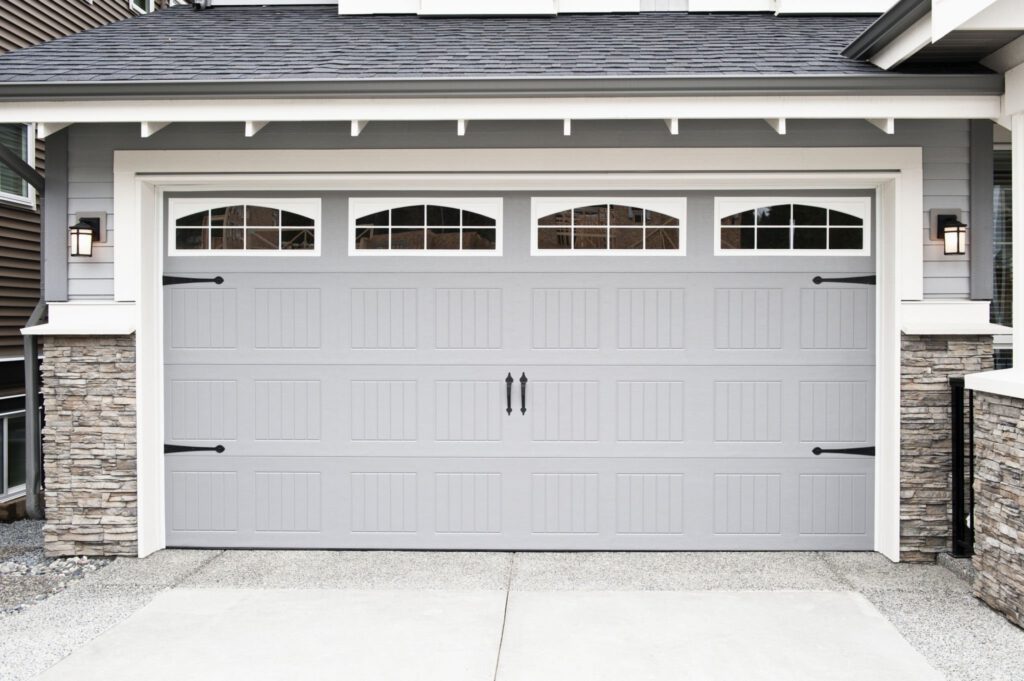A dented garage door can be an unsightly blemish on your home or commercial property. Whether it’s a small dent or a more significant impact, it’s natural to want to restore your garage door’s appearance and functionality. This comprehensive guide walks you through the step-by-step process of fixing a dented garage door, providing valuable tips and insights. Whether you have a wooden or metal gate, we’ve got you covered.
Understanding Garage Door Materials
Before we delve deeper into the garage door repair process, understanding the material of your garage door is crucial, as different materials react differently to dent repair methods. The common types of materials used in garage doors include wood, steel, aluminum, and vinyl.
Wooden Garage Doors
A wooden garage door can provide a beautiful, classic aesthetic to your home. However, they can be prone to dents and scratches. When a wooden door gets dented, fixing it often involves using a wood filler, sanding the area smoothly, and then staining or painting it to match the rest of the door.
Steel and Aluminum Garage Doors
Steel and aluminum garage doors are sturdy and can withstand various weather conditions. However, they are not immune to dents. The excellent news is that minor dents in these metal doors can be fixed relatively easily using household items like a hairdryer and some compressed air.
Vinyl Garage Doors
Vinyl garage doors are low-maintenance and resistant to dents. However, if a dent occurs, it can be tricky to fix because vinyl isn’t as malleable as metal. It may require professional assistance or replacement.
Knowing what your garage door is made of will help determine the best method to remove the dent. In our next sections, we will discuss in detail how to fix dents in both wooden and metal garage doors, enabling you to confidently tackle the question, “How can I fix a dent in my garage door?”
Identifying Types of Dents
Recognizing the type of dent in your garage door is the first step in the repair process. Dents can differ in size, depth, and location, influencing the method required to fix them.
Small Dents
Minor dents are usually shallow and less than a few inches in diameter. These can result from common incidents like a kid’s stray soccer ball or small pebbles kicked up by a lawnmower. Small dents can often be repaired with simple at-home remedies involving heat and rapid cooling to convert the material to its original form.
Large Dents
Large dents are more significant in size and often more profound. They might result from significant impacts, such as a car bumping into the garage door. Large dents may need more effort and sometimes professional intervention, particularly if they affect the door’s functionality.
Creased Dents
A line characterizes creased dents or folds in the door’s material, generally caused by a more forceful impact. While some creased dents can be fixed at home, severe creasing can compromise the door’s structural integrity, and a replacement panel or door might be required.
Dents in Wooden Doors
Dents in wooden doors can be more challenging due to the material’s nature. The repair method is quite different, often involving the use of auto body filler or wood filler, followed by sanding, sealing, and repainting.
Each type of dent has its unique repair strategy. Understanding the type of dent you’re dealing with can help you decide the best course of action for your garage door repair. Armed with this knowledge, you can now answer confidently, “Yes, I can fix a dent in my garage door!” regardless of its type.
Step-by-Step Guide to Fixing a Dented Garage Door
If you’ve discovered a dent in your garage door, don’t worry! Many dents can be fixed with some basic tools and a bit of effort. Follow this step-by-step guide to help you repair your dented garage door:
Step 1: Gather the necessary tools and materials Before you begin, make sure you have the following items on hand:
- Rubber mallet or hammer with a rubber tip
- Block of wood
- Heat source (such as a hairdryer or heat gun)
- Clean cloth and warm water (for cleaning the area)
- Putty knife (for minor touch-ups)
Step 2: Clean the area around the dent Use a clean cloth and warm water to wipe the area surrounding the dent. This will help remove any dirt or debris that could interfere with the repair process.
Step 3: Apply heat to the dent Using a hairdryer or heat gun, apply heat to the dented area. Move the heat source back and forth over the dent for a few minutes. The heat will expand the metal, making it more malleable and easier to work with.
Step 4: Gently tap the dent from the inside With the dent warmed up, go inside your garage and position yourself behind the dented area. Using a rubber mallet or a hammer with a rubber tip, begin tapping the dent from the inside. Start from the outer edges and work your way towards the center, applying gentle and even pressure. Avoid striking the garage door forcefully to prevent further damage.
Step 5: Use a block of wood for larger dents For larger or more stubborn dents, place a block of wood behind the dent on the inside of the door. Use the rubber mallet or hammer to tap the wood, pushing the dent out from the opposite side. This technique helps distribute the force and can assist in reshaping the metal.
Step 6: Check your progress Periodically step back and assess your progress. If the dent is improving, continue tapping and reshaping until you’re satisfied with the results. Be patient, as it may take several attempts to achieve the desired outcome.
Step 7: Touch up the surface (if necessary) Once the dent is mostly fixed, use a putty knife to apply some touch-up paint or filler to any small imperfections or scratches caused by the repair process. This step helps ensure a smooth and seamless appearance.
Remember, for larger or more complex dents, or if you’re unsure about the garage door repair process, it’s always a good idea to consult a professional garage door repair service. They have the expertise and specialized tools to handle challenging repairs and ensure the best possible outcome.
By following these steps and exercising caution, you can often successfully fix minor to moderate dents in your garage door, restoring its appearance and functionality.
Fixing a Dent in a Metal Garage Door
Metal garage doors are commonly found in residential and commercial properties. Here are the steps to repair a dent in a metal garage door:
- Clean the area: Use a clean cloth and warm water to remove dirt or debris from the dented area.
- Apply heat: Use a hairdryer to warm the dent for a few minutes. The heat will expand the metal, making it easier to reshape.
- Gentle tapping: Using a rubber mallet or a hammer with a rubber tip, tap the dented area from inside the garage door. Start from the outer edges and work towards the center, applying gentle and even pressure.
- Woodblock method: Place a block of wood behind the dent for larger dents and tap the wood with a hammer to push the metal back into shape.
- Finishing touches: Once the dent is mainly flattened, use the rubber mallet or hammer to smooth out any remaining imperfections.
Repairing a Dent in a Wooden Garage Door
Wooden garage doors require special care and attention regarding dent repair. Follow these steps to fix a dent in a wooden garage door:
- Clean the area: Like the metal door repair process, start by cleaning the dent with a cloth and warm water to remove dirt or debris.
- Apply moisture: Moisten a cloth or sponge with warm water and place it over the dent for approximately 30 minutes. This will allow the wood to absorb moisture and expand.
- Heat application: Use a hairdryer to apply heat to the dent for a few minutes. This will further aid in expanding the wood fibers.
- Compressed air or vacuum method: Try using compressed air or a vacuum cleaner with a suction cup attachment for shallow dents. Apply the suction to the dent and gently pull until the wood pops back into place.
- Sanding and refinishing: After the dent is repaired, lightly sand the area to smooth out rough edges. Finally, apply a wood finish or paint to match the surrounding door surface.
Professional Help and Cost Considerations
In some cases, the dent may be too severe or the repair process too complex to tackle on your own. In such situations, it’s best to seek the assistance of a professional garage door repair company. They have the expertise and specialized tools to handle more challenging dent repairs.
When considering professional help, remember that the cost of fixing a door dent can vary depending on several factors, such as the size and severity of the dent, the type of garage door, and your location. It’s best to contact a few reputable garage door repair companies in your area and request a quote for the specific dent repair you require. They can assess the damage and provide you with an estimate of the cost involved.

Preventing Future Garage Door Dents
While it’s not always possible to prevent every dent, there are steps you can take to minimize the risk of future dents on your garage door:
- Avoid collisions: Be cautious when parking your vehicles and ensure they are fully inside the garage before closing the door. Also, teach children to avoid playing near the garage door to prevent accidental impacts.
- Install protective measures: Consider installing rubber bumpers or padding on the interior sides of the garage to cushion any accidental impacts.
- Trim nearby foliage: Overhanging tree branches or shrubs can pose a risk of falling debris that could dent your garage door. Regularly trim vegetation near your garage to minimize this risk.
- Regular maintenance: Perform routine inspections and maintenance on your garage door, including lubricating moving parts, tightening screws and bolts, checking the balance and alignment, and promptly addressing any necessary garage door repair. This helps ensure smooth operation and reduces the likelihood of dents caused by mechanical issues.
- Reinforce with reinforcement struts: If you have a wider garage door or live in an area prone to strong winds, consider installing reinforcement struts to provide added support and prevent warping or denting during severe weather conditions.
Repairing a dented garage door is a task that can often be accomplished with the right tools, techniques, and a bit of patience. You can tackle many dent repairs independently by following this article’s step-by-step guide and tips. However, seeking professional help for more complex or severe dents is advisable.
Remember, prevention is key when it comes to dented garage doors. Taking precautions and practicing regular maintenance can go a long way in minimizing the risk of dents in the future. By being proactive, you can keep your garage door looking and functioning at its best for years.
Increasing Garage Door Lifespan with Regular Inspections
Like any other mechanical system, garage doors must be checked and serviced regularly to ensure they work well and last as long as possible. Getting help from experts like Circle B Overhead Door, a trusted local garage door expert in Bryan, TX, and the nearby areas, can be very helpful whether you just learned how to fix a dent in a garage door or want to avoid such problems.
Regular checks include checking for signs of wear and tear, lubricating moving parts, and looking for possible problems. These checks can help keep minor issues from becoming big and expensive and help your garage door last longer.
Remember that a garage door that is well taken care of will last longer and add to the safety and beauty of your home. Be bold and call Circle B Overhead Door if you need help with your garage door. Our team is always ready to help so your garage door stays in great shape for years.







